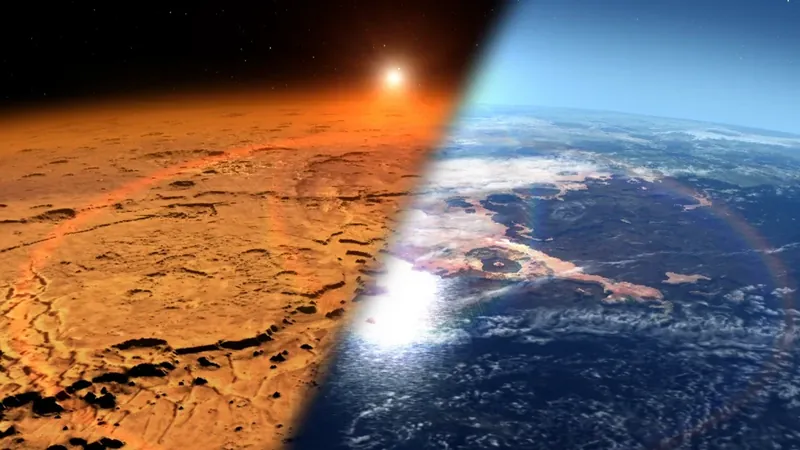
Unraveling Mars' Desolation: Why This Planet Turned Into a Desert While Earth Thrived
2025-07-21
Author: Emma
For eons, scientists have been captivated by a compelling mystery: why did Earth flourish with life while Mars succumbed to a cold, desolate existence? Once upon a time, both planets shared identical building blocks—rocky surfaces, water, sunlight, and carbon—but their destinies diverged drastically.
Mars’ Brief Warmth: A Recipe for Disaster
A groundbreaking study led by Edwin Kite of the University of Chicago presents an intriguing explanation. Mars experienced fleeting periods of warmth due to a slowly brightening sun, but its geological features abruptly cut these wet spells short, casting the planet back into aridity.
Published in the journal Nature, this research builds upon significant findings from NASA’s Curiosity rover, which uncovered carbonate-rich rocks on Mars' surface. These geological clues tell a hidden tale of a planet that possibly once teemed with water but could not sustain it.
Hot and Cold: Mars’ Volatile Past
Mars shows vestiges of ancient riverbeds and lake basins, indicating that liquid water once coursed freely. Kite's research posits that each warm period was initiated by the gradual increase in solar brightness, melting ice and snow, and allowing water to flow.
However, as water traversed the Martian landscape, it absorbed atmospheric carbon dioxide and transformed it into rock-bound carbonate, stripping the atmosphere of greenhouse gases. This cooling cycle ultimately brought water flow to a halt.
Why Earth Thrived: A Stable Carbon Cycle
Earth’s climate has remained remarkably stable for over 3.5 billion years, thanks to an effective carbon cycling system. Volcanic eruptions push carbon dioxide into the atmosphere, while weathering and sedimentation carefully draw it back, maintaining a balance that keeps the climate hospitable.
In stark contrast, Mars has been mostly volcanically inactive for eons, with a lack of volcanic activity leaving it unable to replenish the carbon it lost, resulting in inhospitable dry spells.
The Carbon Puzzle: Where Did Mars' Gases Go?
For years, scientists have pondered the whereabouts of Mars' missing carbon, essential for sustaining liquid water. Initially fruitless rover missions finally struck gold when Curiosity drilled into Mount Sharp's rocks, revealing significant carbonate deposits.
"Researchers have long sought the ‘tomb’ for the Martian atmosphere," Kite remarked, emphasizing how these elusive carbonate formations—which escaped detection from orbit—now provide crucial evidence of carbon concealed within Martian rock.
The Key to Habitability: The Earth-Mars Comparison
Earth enjoys a stable climate due to a continuous recycling of carbon between its atmosphere and crust, unlike Mars, which had a flawed version of this cycle. As solar brightness increased, short-lived warm phases sparked carbonate formation but lacked the volcanic activity needed to restore carbon, leading to brief spells of water followed by extensive dry epochs.
Peeking into Mars' Climate History
Curiosity has been tirelessly exploring Gale Crater—one of Mars' most geologically diverse sites—unearthing samples rich in carbonate over various rock layers. These carbonates may hold the key to understanding Mars' thin atmosphere today.
The data revealed that intermittent liquid water appeared unexpectedly late in Martian history, potentially feeding small, patchy oases but insufficiently allowing life to flourish.
A Lesson from the Red Planet: Habitability Is Fragile
This fresh research alters our perspective on Mars' past and prompts us to rethink what it means for a planet to be habitable. While Earth might seem like the fortunate one, its environmental stability hinges on a precarious carbon balance—one that Mars lost early on.
With ongoing missions like Curiosity and Perseverance, scientists are assembling a clearer narrative. Mars didn’t just accidentally lose its ability to support life; its geological makeup set it on a path toward becoming a lifeless desert.
Kite and his team believe these findings present a testable model for future exploration. As we continue to search for carbonate deposits, we can better understand this self-limiting climate pattern across Mars.
Ultimately, the story whispered by Mars’ rocks serves as a poignant reminder: even when a planet possesses the ideal ingredients for life, without the right balance, it may become a barren wasteland.









 Brasil (PT)
Brasil (PT)
 Canada (EN)
Canada (EN)
 Chile (ES)
Chile (ES)
 Česko (CS)
Česko (CS)
 대한민국 (KO)
대한민국 (KO)
 España (ES)
España (ES)
 France (FR)
France (FR)
 Hong Kong (EN)
Hong Kong (EN)
 Italia (IT)
Italia (IT)
 日本 (JA)
日本 (JA)
 Magyarország (HU)
Magyarország (HU)
 Norge (NO)
Norge (NO)
 Polska (PL)
Polska (PL)
 Schweiz (DE)
Schweiz (DE)
 Singapore (EN)
Singapore (EN)
 Sverige (SV)
Sverige (SV)
 Suomi (FI)
Suomi (FI)
 Türkiye (TR)
Türkiye (TR)
 الإمارات العربية المتحدة (AR)
الإمارات العربية المتحدة (AR)